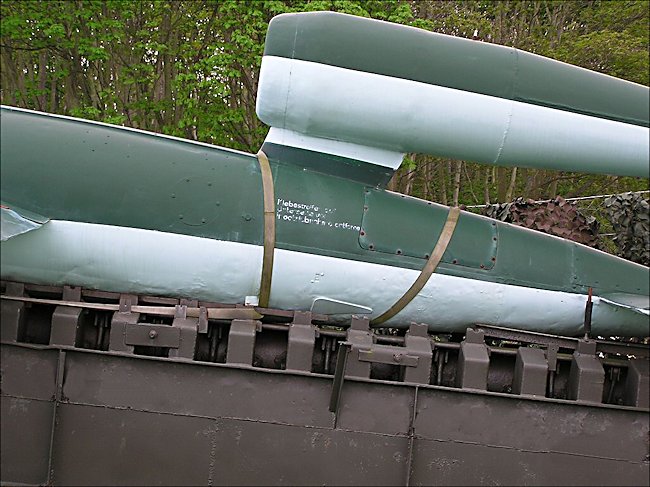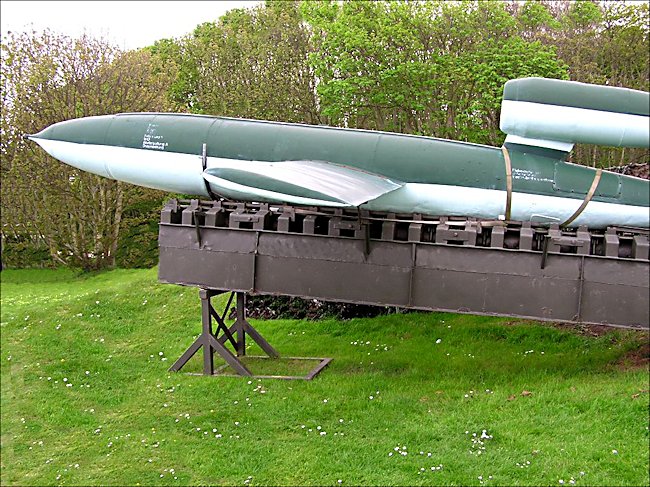V1 Doodlebug Flying Buzz Bomb
My Father has told me stories of when he was a boy hearing and then seeing the V1 doodlebugs flying over south London whilst on his paper round and having to dive to the floor when their engines cut out. He lost school friends, killed when one of these terror weapons demolished their houses. Officially, the Germans called it FZG-76-Flakzielgerat (anti-aircraft target device). The anti-aircraft description was used to fool Allied spies.
It was known by a number of different names in Britain the "doodlebug" "vengeance weapon" "buzz bomb" and "farting fury", along with a number of other comic names. A company called Fieseler designed and gave it a the number code Fi-103. It was called the pilotless aircraft Vergeltungswaffe (retaliation weapon) 1, or V-1 by the Nazi Propaganda Ministry.

A V-1 flying bombs overall length was just over 25 feet, with a wingspan of 17 feet. It used the same 80-octane gasoline fuel that was used by trucks. It was also easy and cheap to make compared to a fighter or bomber. It carried a huge 1,870 pound warhead but it was not very accurate. It could only hit very large targets. It was therefore directed at Greater London. It allowed the Germans to hit back at the Allies without risking losing more of their depleted Luftwaffe's bomber fleet.
In August 1943 the Flakregiment 155 ('N), a new Luftwaffe unit was formed. The anti-aircraft name was, again, aimed at fooling Allied intelligence. The new unit trained on the western side of Peenemuende, and Usedom Island in the Baltic Sea. The launching crews practiced readying the small, jet-propelled planes and firing them over the Baltic. In April 1944 the first 1,000 V1 flying bombs came off the Volkswagen assembly line. By June 1944, the Flakregiment 155 ('N) unit were in France.
There was a problem with the launching equipment. The larger ramps had proved too attractive to Allied bombing attacks. It was decided that lightweight launching ramps would be used. By 3:30 am, on June 13, only ten firing ramps were ready. The V-1 was launched off the ramp rails in the same way that a navy jet plane is catapulted off the flight deck of an aircraft carrier.

The flying bomb a maximum speed of about 400 mph. The new British twin jet engine RAF Gloucester meteors that were sent up after these bombs had a speed of 800mph. In the first wave ten V1's were launched. Two of them crashed into the English Channel. The other four reached England; two landed in Kent, one in Surry, and one crashed in London, the intended target of all of them. The London bomb came down in Bethnal Green, East London, about three miles away from its Tower Bridge target point. The explosion killed three people and knocked out a railway bridge. The others exploded after launch. Although only four flying bombs reached England during this first launch, hundreds more were launched during the next several weeks.
How did the V1 know when to dive? It had a small, propeller like device on its nose that was connected to the bomb's autopilot. As it flew through the air, the propeller spun. After a preset amount number of turns the diving controls were activated and pointed the bomb earthward at a steep angle. The fuel rushed forward and the engine cut out. People on the ground had about 15 seconds to take cover before it hit the ground. This knowledge saved many peoples lives. By June 18, 1944 500 flying bombs had been launched.
At first, to try and stop the flying bomb attacks eight fighter squadrons, equipped with Hawker Typhoons, Supermarine Spitfire IXs and XIVs, and Hawker Tempest Vs, flew standing patrols. More anti aircraft guns and extra barrage balloons were installed near London. Because the buzz bombs traveled at more than 400 miles per hour, Fighters underwent modifications to make them faster so they could chase the flying bombs. The piston-engine fighters needed all the speed they could muster.
A few pilots discovered that they could slide a wing under the wingtip of the V1 "flying blowlamp" and tip it out of control to the ground. It worked because flying bombs had a very delicate gyro mechanism; any sudden, violent movement caused it to malfunction. The standard .303 caliber machine gun bullets bounced off the rounded steel frame of the V1 in many cases.
The 20 mm cannon was very effective but had a shorter range. If you got too close when you tried to shoot down a doodlebug there was a danger that it would blow up and damage your plane. In late summer of 1944 the Allied armies had moved inland from the D-Day beaches and the launch sites on the Normandy coast were captured. More than 2,000 of them had hit London. Others had come down on the surrounding suburbs.
V1 Doodlebug books


Tweet